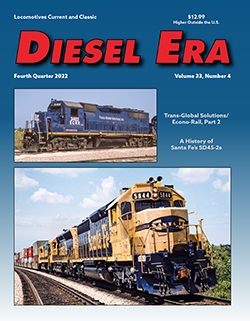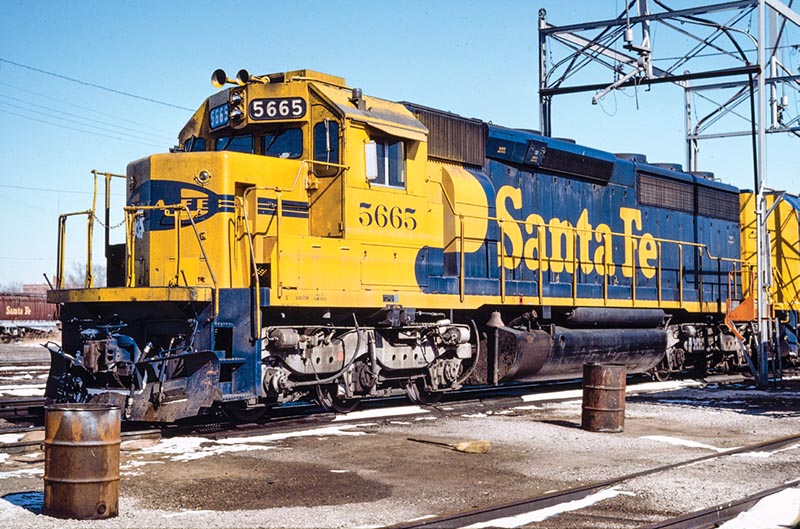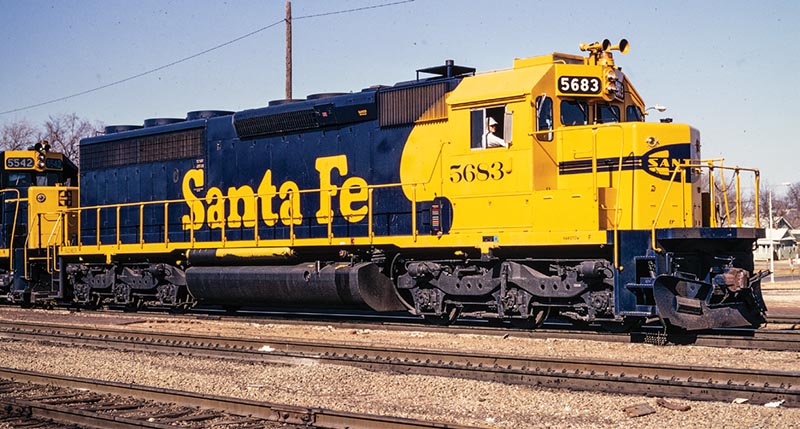 By Peter Limas/photos from the collection of Kevin EuDaly, Paul Wester, and others as noted
By Peter Limas/photos from the collection of Kevin EuDaly, Paul Wester, and others as noted
When Electro-Motive Division (EMD) introduced its Dash-2 line, they included the SD45-2 as part of the product catalog offerings. Atchison, Topeka & Santa Fe (ATSF) invested heavily in EMD’s original SD45 line, acquiring 125 regular-body units and 49 cowl-body (40 F45s and nine FP45s) from 1966 to 1970. It was evident that the railroad wanted a locomotive that could sustain speed to power its highest priority freights and the developing intermodal traffic, then receiving attention as the road’s Super C train.
Shifting to Six Axles
From the early diesel era and into the 1960s, Santa Fe was essentially a four-axle railroad. Experiencing increased traffic around 1960, Santa Fe ordered 130 new locomotives, Alco’s RSD-15 and EMD’s SD24. This collection represented the road’s first high-horsepower (2,400 hp), six-axle freight units. The other freight locomotives with six axles were A-1-A (middle axle not powered) units like its RSD-4 and RSD-5 trucks or the lower horsepower RSD-7. Santa Fe’s 50 examples of Alco’s RSD-15 (800–849 delivered in 1954 and 1955) and its 80 EMD SD24s (900–979 delivered in 1959 and 1960) were rated at handling roughly the same tonnage and developing the same horsepower. While able to handle cargo tasked behind them, these units did lack higher horsepower-per-axle rating needed for faster service.

ABOVE: ATSF 5665 at Dodge City, Kan., in 1980. The 5665 has xenon strobe lights added during the Super C era; some units would carry these strobes well into the 1980s. —Kevin EuDaly collection
Santa Fe returned to four-axle power ordering EMD’s GP20, followed by GP30 and GP35 models. The latter two groups (GP30 and GP35) revealed some electrical concerns and were slippery in the tractive effort department. When General Electric (GE) entered the North American diesel locomotive market in earnest and on its own around 1960, Santa Fe supported the company with purchases of its U25B, though it would pass on GE’s follow-up 1960s four-axle U-Boats and early six-axle offerings from this Universal series.
The mid-1960s saw a change (from four-axle to six-axle) in Santa Fe’s motive-power buying beginning with EMD’s popular 1966 line. The road initially ordered EMD’s 3,000-hp SD40s (1700–1719 delivered in 1966); these units had roughly the same horsepower ratio per axle comparable to some of the four-axle units on the roster and were not a big leap up. The same year its 20 SD40s arrived, Santa Fe also bought its first SD45s. The road took to EMD’s flared-radiator unit in a big way, with orders that would total more than 125 units by 1970. The last SD45 group ordered by Santa Fe was built with a 59:18 gear ratio and was assigned to Super C, operating for about two years in this service.

ABOVE: Eight-month-old ATSF 5683 shows its as-built appearance in February 1974. —Kevin EuDaly collection
With its F-units approaching an age for rebuilding or retirement, Santa Fe ordered EMD’s FP45 and GE’s U28CG and U30CG offerings to upgrade its passenger locomotive fleet. In addition to those two uncommon passenger locomotives, Santa Fe would also buy regular freight versions of two higher-horsepower GE six-axle offerings with U33C and U36C models added. The road did buy lower-horsepower locomotives from EMD (GP38) and GE (U23B) during these same years.
With its Super C in operation since 1968, Santa Fe was using new locomotives out of the passenger fleet (including the occasional aged F-unit), F45s, U33Cs, and SD45s to power the train. The stage was set for a continuation of ATSF’s buying trend when EMD introduced its “Dash 2” line in 1972…

ABOVE: ATSF 5700 and U36C 8745 lead a mixed freight through Matfield Green, Kan., in the Flint Hills area. It’s been nine years since 5700 wore its famous Bicentennial paint scheme. The 5700 has a K3 air horn in place of its original Leslie example. — Kevin EuDaly collection



